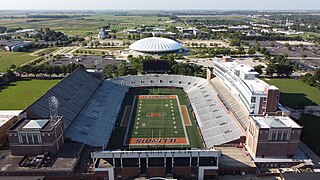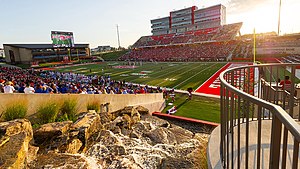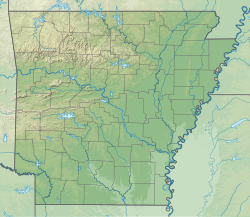
CEFCU ('sef-kyü) Stadium, formerly known as Spartan Stadium, is an outdoor athletic stadium on the west coast of the United States, located in the Spartan Keyes neighborhood of central San Jose, California. Owned by San José State University, the venue is the longtime home of Spartan football; it also hosts the university's commencement ceremony on Memorial Day weekend, and occasional high school football games. Known as Spartan Stadium for over eight decades, it was renamed in 2016.

Memorial Stadium is a stadium on the campus of the University of Illinois Urbana-Champaign in Champaign, Illinois, United States. The stadium, used primarily for football, is a memorial to the university's students who died in World War I; their names are engraved on the nearly 200 pillars surrounding the stadium's façade. With a capacity of 60,670, the stadium is primarily used as the home of the university's Fighting Illini football team.

Mountaineer Field at Milan Puskar Stadium is an American football stadium in Morgantown, West Virginia, on the campus of West Virginia University. It opened in 1980 and serves as the home field for the West Virginia Mountaineers football team. On the day the stadium opened, at an opening ceremony, John Denver touched down on the field in a helicopter, performed the song "Take Me Home, Country Roads," and then immediately departed by helicopter. The facility is named for Milan Puskar, a Morgantown resident and founder of Mylan Pharmaceuticals, Inc. who donated $20 million to the university in 2004. The playing surface retains the stadium's original name of Mountaineer Field, which was also the name of WVU's previous football stadium. The stadium’s design was inspired by Jack Trice Stadium, which opened a few years earlier at Iowa State University.

Darrell K Royal Memorial Stadium, located in Austin, Texas, on the campus of the University of Texas, has been home to the Longhorns football team since 1924. The stadium has delivered a home field advantage with the team's home record through November 24, 2023 being 399–122–10 (.761). The official stadium seating capacity is 100,119, making the stadium the fourth largest in the Southeastern Conference, the seventh largest stadium in the United States, and the ninth largest stadium in the world.

David Booth Kansas Memorial Stadium is a college football stadium in Lawrence, Kansas, on the campus of the University of Kansas. The stadium was opened in 1921, and is the seventh oldest college football stadium in the country, and is widely recognized as the oldest west of the Mississippi River. It is the home stadium of the Kansas Jayhawks football team.

Memorial Stadium is a stadium in Bloomington, Indiana, United States. It is primarily used for football, and has been the home of Indiana Hoosiers football since its opening in 1960. It is the 15th largest football stadium in the Big Ten Conference, with a capacity of 52,626. The field has a conventional north-south alignment, at an approximate elevation of 771 feet (235 m) above sea level.

Veterans Memorial Stadium at Larry Blakeney Field is a stadium in Troy, Alabama. It is primarily used for American football, and is the home field of the Troy University Trojans. The seating capacity is 30,470. The stadium was originally built in 1950, and has regularly been expanded, renovated and improved since then. The stadium was named in honor of the college students and local residents who gave their lives during World War II. The field received its name from retired head coach Larry Blakeney, the coach with the most wins in Troy history.

Malone Stadium is a stadium in Monroe, Louisiana, United States, on the campus of the University of Louisiana at Monroe. It is primarily used for football and is the home field of the ULM Warhawks. The stadium, named for former coach James L. Malone, opened in 1978 and has a seating capacity of 27,617 people.

Vaught–Hemingway Stadium at Hollingsworth Field is an outdoor athletic stadium located in University, Mississippi, United States. The stadium serves as the home for the University of Mississippi Rebels college football team. The stadium is named after Johnny Vaught and Judge William Hemingway. Since its expansion in 2016, it is the largest stadium in the state of Mississippi with a capacity of 64,038 and also holds the state record for attendance at 68,126.

Wallace Wade Stadium, in full Brooks Field at Wallace Wade Stadium, is a 35,018-seat outdoor stadium in the southeastern United States, located on the campus of Duke University in Durham, North Carolina. Primarily used for American football, it is the home field of the Duke Blue Devils of the Atlantic Coast Conference.

Jack Trice Stadium is a stadium located in Ames, Iowa, United States. Primarily used for college football, it is the home field of the Iowa State Cyclones. It is named in honor of Jack Trice, Iowa State's first African American athlete, who died of injuries sustained during a 1923 game against Minnesota. The stadium opened on September 20, 1975, with a 17–12 win over Air Force.

Faurot Field at Memorial Stadium is an outdoor sports stadium in Columbia, Missouri, United States, on the campus of the University of Missouri. It is primarily used for football and serves as the home field for the Missouri Tigers' program. It is the third-largest sports facility by seating capacity in the state of Missouri, behind The Dome at America's Center in St. Louis and Arrowhead Stadium in Kansas City. In 1972, Memorial Stadium's playing surface was named Faurot Field in honor of longtime coach Don Faurot.

Arthur L. Williams Stadium is a 25,000-seat football stadium located on the campus of Liberty University in Lynchburg, Virginia, USA. The stadium was built in 1989 and plays host to Liberty Flames football, which is a part of the NCAA Division I - Football Bowl Subdivision (FBS). A new field house has recently been constructed at the north end of the stadium. This new facility houses a new home locker room, coaches offices, meeting rooms and training facility as well as a 16,000-square-foot (1,500 m2) weight room. In the 2009 off season, Liberty University added a video scoreboard on the north end of the field. The video scoreboard measured 20 feet (6 m) tall and 36 feet (11 m) wide. This video board was replaced by a massive new high-definition video board in time for the 2018 football season.

Bobcat Stadium is an outdoor athletic stadium in the western United States, located on the campus of Montana State University in Bozeman, Montana. It is the home of the Montana State Bobcats college football team of the Big Sky Conference.

Ken Riley Field at Bragg Memorial Stadium is a 25,500-seat football stadium in Tallahassee, Florida, United States. It opened in 1957 and was renovated in 1982. It is home to the Florida A&M Rattlers football team.

Truist Stadium, formerly Aggie Stadium, is a 21,500-seat multi-purpose stadium in Greensboro, North Carolina. It is located at the north end of the North Carolina A&T State University campus.

Allen E. Paulson Stadium at Evans Family Field is a 25,000-seat on-campus football stadium in Statesboro, Georgia. It is home to the Georgia Southern Eagles football team and the focal point of Erk Russell Athletic Park.

Ernest Hawkins Field at Memorial Stadium is an athletic stadium located in Commerce, Texas. It is primarily used for American football, and is the home field of the East Texas A&M University Lions football team, Texas A&M-Commerce Men's and Women's Track and Field, and the Commerce High School Tigers Football team of the Commerce Independent School District. Prior to 1996, the stadium was named "East Texas State Memorial Stadium, and until the end of the 2017 season, it was known as Texas A&M-Commerce Memorial Stadium." The stadium was built in honor of the 78 Texas A&M-Commerce alums and students who fought and died during World War II. The stadium was renamed Ernest Hawkins Field at Memorial Stadium was formally changed in November 2017 in honor of longtime Lion football coach Ernest Hawkins.

Provost Umphrey Stadium is a 16,000-seat multi-purpose stadium located on the campus of Lamar University in Beaumont, Texas. The stadium, home to the Lamar Cardinals football team, is located next to the Montagne Center. While primarily used for football, Provost Umphrey Stadium is also a concert venue with seating up to 20,000 for concerts. The stadium was completely renovated in 2009 and is designed to allow for a future expansion to 28,000.

Bob Ford Field at Tom & Mary Casey Stadium is a football stadium in Albany, New York, owned and operated by the University at Albany, SUNY and hosts the school's football team, as well as their soccer program. The stadium, with an initial seating capacity of 8,500 opened on September 14, 2013, when Albany made its debut in Colonial Athletic Association football against Rhode Island. It was renamed Bob Ford Field at Tom and Mary Casey Stadium in 2015 after Tom & Mary Casey gave a $10 million gift to the school. It replaced University Field as the school's current stadium.

























